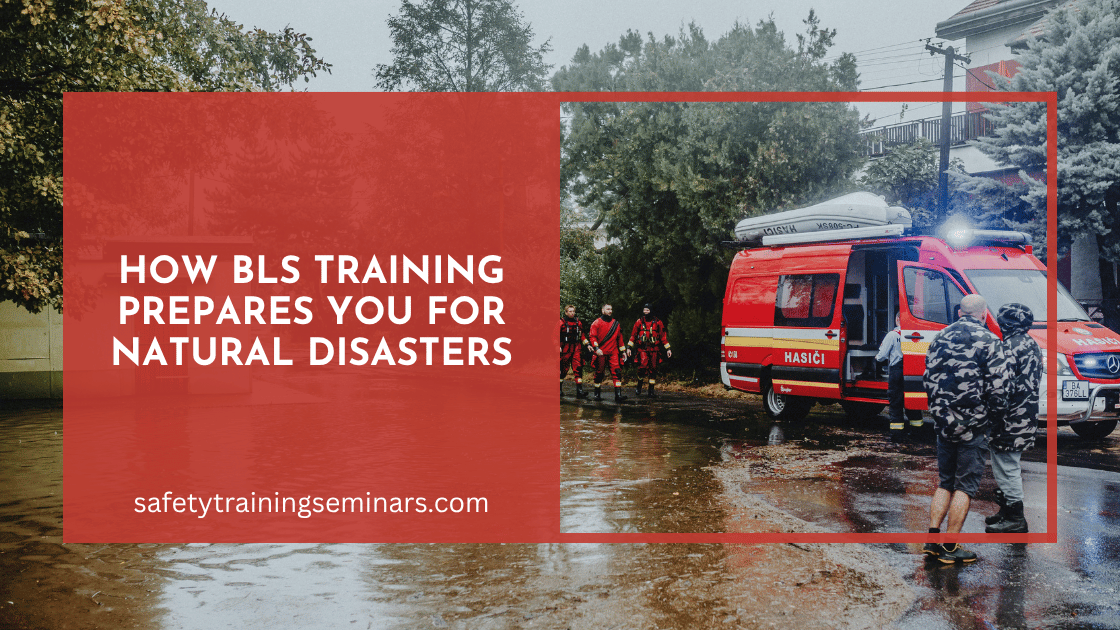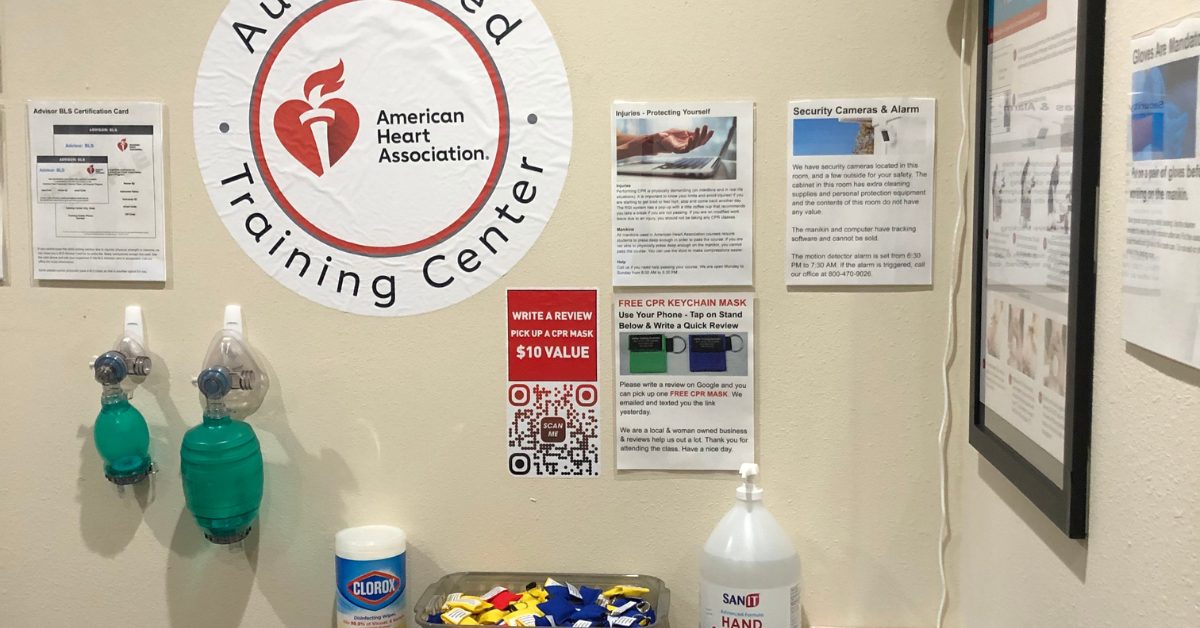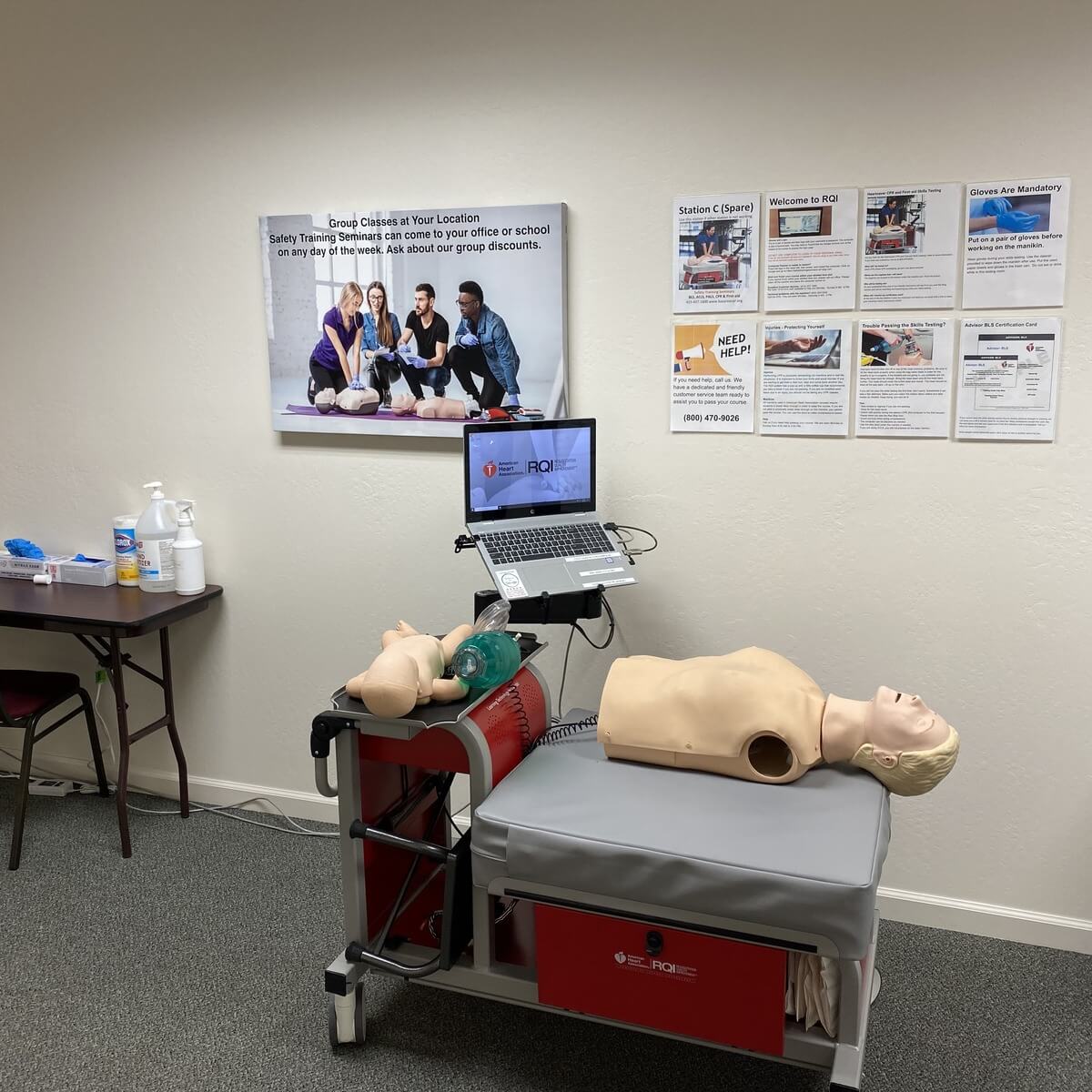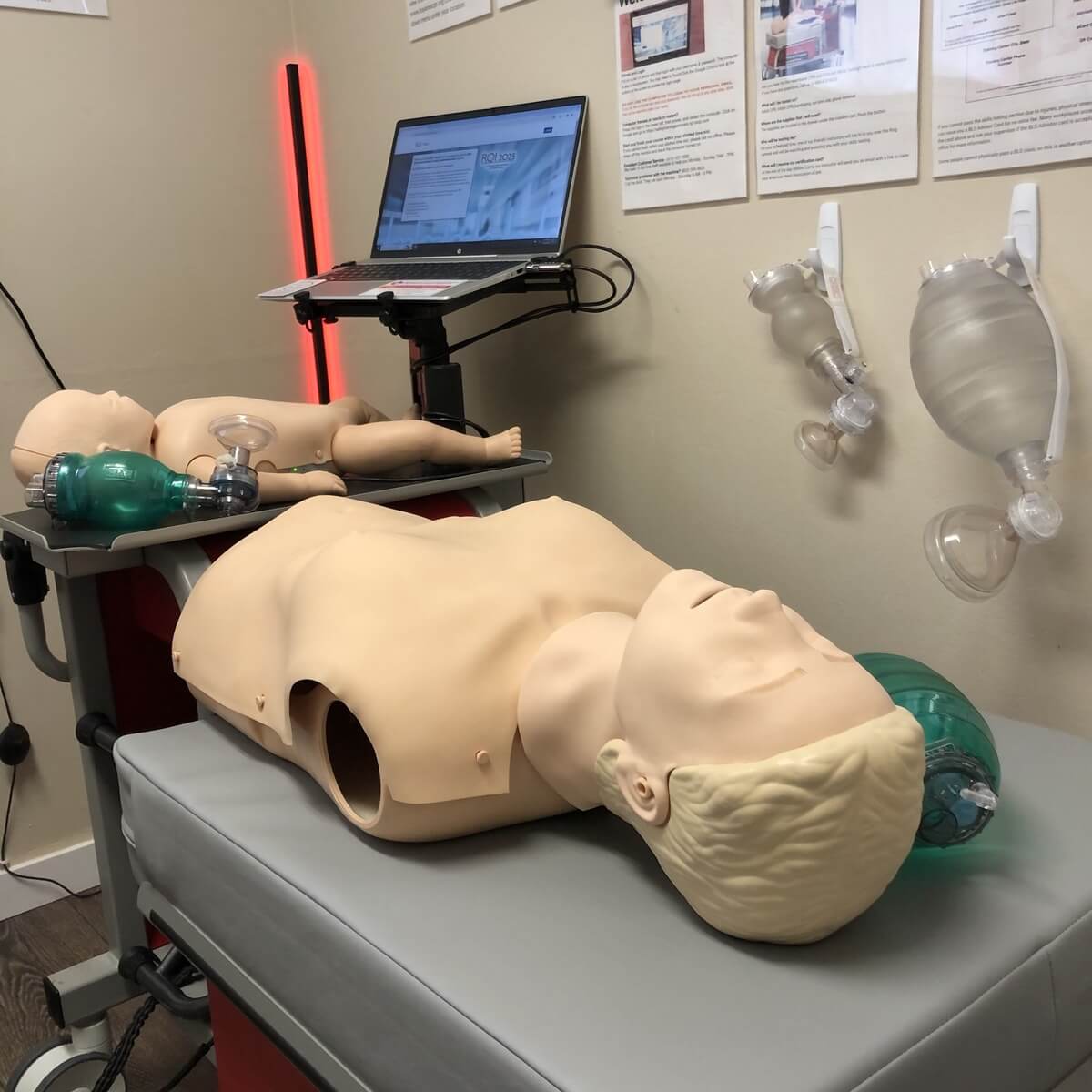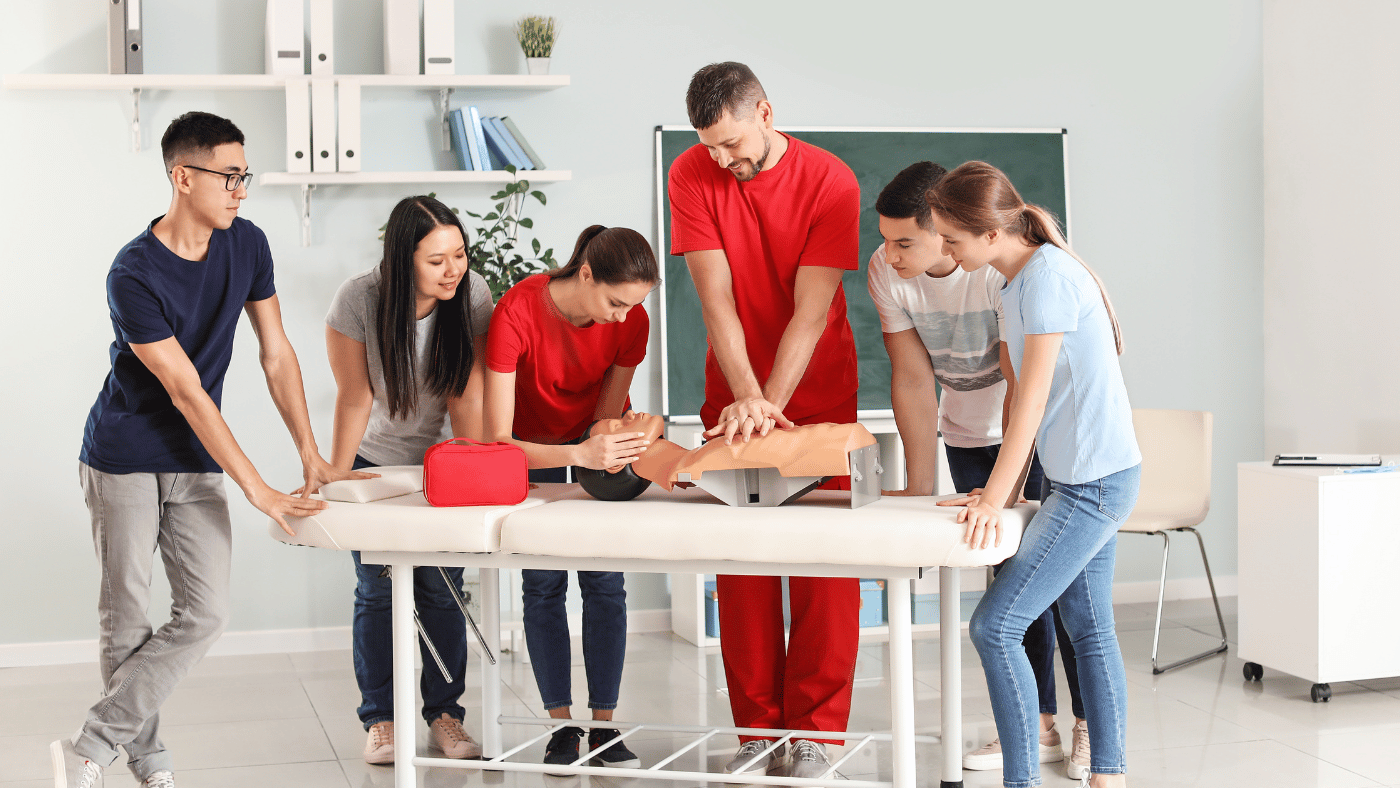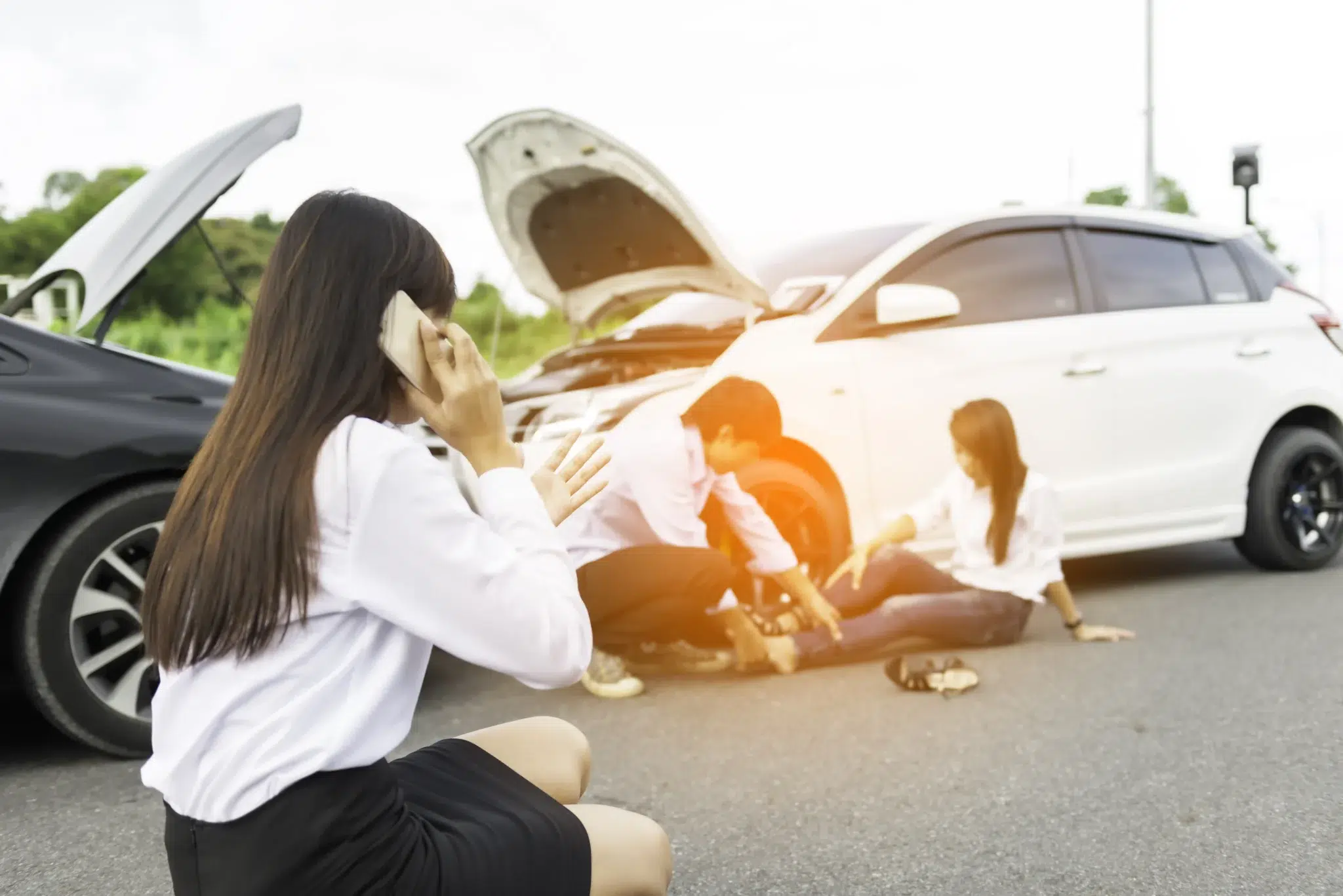Natural disasters strike without warning. Earthquakes collapse buildings. Hurricanes flood communities. Wildfires force mass evacuations. When emergency services are overwhelmed or unreachable, your Basic Life Support (BLS) skills become the difference between life and death.
BLS training equips you with essential life-saving techniques that prove invaluable during natural disasters. This certification goes beyond standard CPR—it teaches you systematic approaches to emergency care, team coordination, and critical decision-making under pressure. Whether you’re a healthcare professional or concerned citizen, BLS training transforms you into a first responder when disasters strike your community.
During catastrophic events, professional emergency responders face unprecedented challenges. Roads become impassable. Hospitals reach capacity. Communication systems fail. These scenarios create a critical gap in emergency medical care—a gap that BLS-trained individuals can fill. Your training becomes a community asset when traditional emergency services cannot reach those who need help most.
This comprehensive guide explores how BLS training prepares you for natural disaster response, the specific skills you’ll gain, and why this certification is essential for disaster preparedness. You’ll discover real-world applications of BLS techniques during emergencies and learn how to maintain your skills for maximum effectiveness when disasters strike.
Understanding BLS Training Components
Basic Life Support training encompasses several core competencies that directly apply to disaster scenarios. The American Heart Association’s BLS curriculum focuses on high-quality cardiopulmonary resuscitation (CPR), automated external defibrillator (AED) use, and effective team communication during medical emergencies.
High-Quality CPR Skills
BLS training teaches you to perform chest compressions at the correct depth, rate, and frequency. During natural disasters, cardiac arrest cases increase dramatically due to stress, trauma, and underlying medical conditions. Your ability to deliver consistent, effective chest compressions can sustain life until advanced medical care becomes available.
The training emphasizes proper hand placement, compression depth of at least 2 inches for adults, and a rate of 100-120 compressions per minute. You’ll learn to minimize interruptions in compressions and allow complete chest recoil between compressions. These technical skills become crucial when treating disaster victims experiencing cardiac emergencies.
AED Operation and Safety
Automated external defibrillators save lives during sudden cardiac arrest events. BLS certification teaches you to operate AEDs safely and effectively, even in challenging environments common during disasters. You’ll understand when to use an AED, how to ensure patient and rescuer safety, and proper electrode placement techniques.
During natural disasters, power outages and debris can complicate AED use. BLS training prepares you to adapt these devices to various environmental conditions while maintaining safety protocols. This knowledge proves essential when treating cardiac arrest patients in less-than-ideal circumstances.
Team Dynamics and Communication
Effective emergency response requires coordinated teamwork. BLS training emphasizes clear communication, role assignment, and leadership during resuscitation efforts. These skills translate directly to disaster response scenarios where multiple responders must work together efficiently.
You’ll learn to communicate patient status clearly, delegate tasks appropriately, and maintain situational awareness during high-stress situations. This training becomes invaluable when coordinating with other BLS-certified individuals, emergency responders, or volunteers during disaster response efforts.
BLS Applications During Specific Natural Disasters
Different types of natural disasters present unique medical challenges. BLS training provides versatile skills that adapt to various emergency scenarios, making you prepared for multiple disaster types.
Earthquake Response
Earthquakes cause immediate trauma injuries and secondary cardiac events from shock and stress. Building collapses create confined spaces where traditional emergency response proves difficult. BLS-trained individuals can provide immediate care in these challenging environments.
Crush injuries are common during earthquake disasters. While BLS training doesn’t cover advanced trauma care, it teaches you to recognize when CPR is appropriate versus when other interventions take priority. You’ll understand how to maintain airway patency in victims trapped under debris and provide rescue breathing when chest compressions aren’t feasible.
The systematic approach taught in BLS training helps you assess multiple casualties quickly and prioritize care effectively. This triage mindset proves crucial when responding to earthquake scenarios with numerous victims requiring immediate attention.
Hurricane and Flood Emergency Care
Flooding and storm surge create unique medical emergencies. Drowning victims require immediate respiratory support, and BLS training teaches effective rescue breathing techniques. You’ll understand how to clear airways of water and debris while maintaining cervical spine precautions.
Hypothermia becomes a significant concern during flood disasters. BLS training teaches you to recognize altered mental status and provide appropriate support while avoiding further heat loss. Your skills in patient assessment help identify life-threatening complications requiring immediate intervention.
Power outages during hurricanes limit access to advanced medical equipment. BLS certification emphasizes manual techniques that don’t require electrical power, making you capable of providing life-saving care when technology fails.
Wildfire Evacuation Scenarios
Wildfire evacuations create panic situations where cardiac events increase substantially. Smoke inhalation affects respiratory function, requiring immediate airway management skills taught in BLS certification. You’ll understand how to position patients for optimal breathing and recognize signs of respiratory distress.
Vehicle accidents increase during mass evacuations as people flee wildfire zones. BLS training prepares you to provide emergency care at accident scenes while maintaining personal safety. Your ability to perform CPR in vehicles or on roadways becomes crucial during evacuation emergencies.
Heat-related emergencies are common during wildfire events. BLS certification teaches you to recognize altered mental status from heat exhaustion and provide appropriate support while cooling measures are implemented.
Winter Storm and Blizzard Response
Extreme cold creates multiple medical emergencies. Hypothermia affects heart rhythm and circulation, making effective CPR techniques essential for survival. BLS training teaches you to modify compression techniques for hypothermic patients and understand when warming measures take priority.
Carbon monoxide poisoning increases during winter storms as people use alternative heating sources. BLS certification helps you recognize altered mental status from carbon monoxide exposure and provide appropriate respiratory support while ensuring scene safety.
Isolation during blizzards means extended response times for professional emergency services. Your BLS skills must sustain patients for longer periods, requiring a thorough understanding of fatigue management and effective compression techniques over extended timeframes.
Essential BLS Skills for Disaster Preparedness
Certain BLS competencies prove especially valuable during natural disaster response. Understanding these key skills helps you focus your training efforts on techniques with maximum disaster application potential.
Airway Management Techniques
Maintaining open airways becomes challenging during disasters when patients may be trapped, unconscious, or affected by smoke inhalation. BLS training teaches you head-tilt, chin-lift maneuvers and jaw-thrust techniques for trauma patients. These skills prove essential when treating disaster victims with potential spinal injuries.
You’ll learn to recognize complete versus partial airway obstructions and provide appropriate interventions. During disasters, debris, water, or smoke can compromise airways, making these skills crucial for patient survival.
Recognition of Cardiac Arrest
BLS certification teaches you to quickly identify cardiac arrest through systematic patient assessment. During disasters, stress and chaos can mask the signs of cardiac emergencies. Your training helps you distinguish between unconsciousness and cardiac arrest, ensuring appropriate intervention timing.
You’ll understand how to check for pulse and breathing effectively, even when environmental noise and distractions complicate assessment. This systematic approach proves invaluable during disaster scenarios with multiple competing priorities.
Effective Ventilation Techniques
Providing rescue breathing becomes essential when treating respiratory emergencies common during disasters. BLS training teaches proper mask seal techniques, appropriate ventilation rates, and recognition of adequate chest rise. These skills prove crucial when treating drowning victims, smoke inhalation cases, or crush injury patients.
You’ll learn to coordinate ventilations with chest compressions during CPR and understand when to modify techniques based on patient response. This adaptability becomes essential during extended resuscitation efforts common in disaster scenarios.
Training Requirements and Certification Process
Obtaining BLS certification involves structured training that prepares you for real-world emergency response. Understanding the certification process helps you choose appropriate training programs and maintain your skills effectively.
Initial Certification Requirements
BLS certification requires completion of both online coursework and hands-on skills testing. The online portion typically takes 1-2 hours and covers theoretical knowledge, while skills testing requires 30 minutes of practical demonstration with certified instructors.
American Heart Association certified training centers like Safety Training Seminars provide official BLS certification recognized nationwide. These programs maintain standardized curricula ensuring consistent skill development across all participants.
The certification process includes written assessments testing your knowledge of emergency response protocols, CPR techniques, and AED operation. Practical skills testing evaluates your ability to perform high-quality chest compressions, operate AEDs safely, and communicate effectively during simulated emergencies.
Recertification and Skill Maintenance
BLS certification expires every two years, requiring recertification to maintain current credentials. However, disaster preparedness demands more frequent skill practice to ensure competency during high-stress situations.
Regular practice sessions help maintain muscle memory for chest compression techniques and AED operation. Consider joining community emergency response teams or volunteer organizations that provide ongoing training opportunities beyond basic recertification requirements.
Many training centers offer refresher courses between certification periods. These sessions help you practice skills with updated equipment and learn about new techniques or protocol changes that improve emergency response effectiveness.
Choosing Quality Training Programs
Not all BLS training programs provide equal preparation for disaster response scenarios. Look for American Heart Association authorized training centers that offer hands-on practice with realistic emergency simulations.
Quality programs emphasize skill practice over lecture time, ensuring you develop muscle memory for critical techniques. They also provide opportunities to practice in various environmental conditions that simulate disaster scenarios.
Avoid online-only certification programs that don’t include hands-on skills verification. BLS competency requires practical demonstration with feedback from qualified instructors who can identify and correct technique issues.
Building Community Disaster Response Capacity
Individual BLS certification contributes to broader community resilience during natural disasters. Understanding how your skills integrate with community emergency response efforts maximizes your disaster preparedness impact.
Neighborhood Response Teams
Many communities organize neighborhood emergency response teams that coordinate disaster preparedness efforts. BLS-certified residents provide immediate medical response capabilities while professional services respond to multiple emergencies simultaneously.
These teams practice coordinated response scenarios that simulate natural disaster conditions. Your BLS skills become part of a larger emergency response system that can operate independently when traditional services are overwhelmed or inaccessible.
Participating in community response teams provides regular skill practice opportunities and helps you understand how BLS techniques integrate with other emergency response functions like search and rescue, communications, and evacuation coordination.
Workplace Emergency Preparedness
BLS certification enhances workplace disaster preparedness by providing immediate medical response capabilities during emergencies. Businesses benefit from having trained employees who can respond to cardiac emergencies while emergency services are contacted.
During natural disasters affecting business operations, BLS-trained employees become valuable assets for employee safety and emergency response coordination. Your skills provide immediate medical support for colleagues experiencing stress-related cardiac events or disaster-related injuries.
Consider advocating for group BLS training at your workplace. Many training centers offer corporate programs that certify multiple employees simultaneously, creating a network of trained responders within your organization.
Integration with Professional Services
BLS certification creates a common skill foundation that allows you to assist professional emergency responders during disasters. Paramedics, EMTs, and hospital staff recognize BLS competencies and can quickly integrate your assistance into their response efforts.
Understanding BLS protocols helps you communicate effectively with professional responders about patient status and care provided. This communication ability becomes crucial during disaster scenarios with multiple casualties requiring coordinated care.
Your BLS skills can extend the reach of professional services by providing initial care while responders handle the most critical cases. This force multiplication effect improves overall community response capacity during large-scale emergencies.
Real-World Disaster Applications
Understanding how BLS skills apply in actual disaster scenarios helps you prepare mentally and practically for emergency response situations. These examples illustrate the practical value of BLS certification during natural disasters.
Hurricane Katrina Response Lessons
During Hurricane Katrina, traditional emergency services were overwhelmed by the scope of the disaster. Civilians with medical training, including BLS certification, provided crucial immediate care for cardiac emergencies and respiratory issues caused by stress, heat, and contaminated flood water.
BLS-trained volunteers assisted in evacuation centers by providing CPR for elderly evacuees experiencing cardiac events from the stress of displacement. Their skills bridged the gap between initial medical emergencies and the arrival of overwhelmed professional medical services.
The disaster highlighted the importance of portable AEDs in evacuation centers and emergency shelters. BLS-trained individuals operated these devices effectively, saving lives when advanced cardiac life support wasn’t immediately available.
California Wildfire Medical Response
Recent California wildfires demonstrated the value of BLS skills during evacuation scenarios. Traffic accidents during mass evacuations created immediate needs for CPR and AED use while emergency services focused on fire suppression and evacuation coordination.
BLS-trained residents provided immediate care for neighbors experiencing cardiac events from stress and smoke inhalation. Their skills proved essential in rural areas where emergency response times were extended due to road closures and resource allocation to fire suppression.
Community emergency response teams with BLS-trained members effectively triaged medical emergencies during evacuations, ensuring the most critical patients received priority attention when professional services arrived.
Earthquake Response Success Stories
The 1994 Northridge earthquake created numerous scenarios where BLS skills proved life-saving. Collapsed buildings trapped victims requiring immediate CPR and airway management while search and rescue teams worked to create access for professional medical responders.
BLS-trained individuals provided sustained CPR for extended periods while rescue teams worked to extract victims from debris. Their ability to maintain effective chest compressions for longer durations proved crucial for patient survival during complex rescue operations.
Hospital staff with BLS certification continued providing emergency care when backup power systems failed and advanced life support equipment became unavailable. Their manual skills maintained patient care continuity during infrastructure failures.
Maximizing Your Disaster Preparedness Investment
BLS certification represents just one component of comprehensive disaster preparedness. Understanding how to integrate your training with other preparedness measures creates a more effective emergency response capability.
Equipment and Supply Considerations
BLS skills prove most effective when supported by appropriate equipment and supplies. Consider assembling a disaster medical kit that includes pocket masks, AED units, and basic first aid supplies that complement your BLS training.
Portable AEDs have become increasingly affordable and user-friendly. Having access to an AED during disasters significantly improves your ability to treat cardiac arrest cases effectively. Many community organizations purchase group AEDs for shared emergency response use.
Practice your BLS skills with the specific equipment you’ll have available during disasters. Different pocket mask designs and AED models require familiarization to ensure effective use during high-stress emergency situations.
Ongoing Education and Skill Development
BLS certification provides a foundation for more advanced emergency medical training. Consider pursuing first aid certification, wilderness medicine training, or community emergency response team (CERT) training to expand your disaster response capabilities.
Advanced training programs build on BLS foundations by teaching trauma care, wound management, and medical emergency assessment skills. These expanded capabilities make you more valuable during disaster response scenarios with diverse medical needs.
Regular skill practice maintains proficiency and builds confidence for actual emergency response. Join training groups, volunteer with emergency services, or participate in disaster preparedness exercises that provide realistic practice opportunities.
Family and Personal Preparedness Integration
BLS skills protect your family members during disasters when professional medical services may be unavailable. Teaching basic emergency recognition skills to family members helps them identify when your BLS training is needed and how to assist effectively.
Create family emergency action plans that account for medical emergencies and incorporate your BLS capabilities into response protocols. Family members should understand how to contact emergency services, locate AEDs, and provide basic assistance during CPR efforts.
Consider obtaining BLS certification for multiple family members to increase your household’s disaster response capabilities. Group training sessions often provide cost savings while ensuring multiple family members can respond to medical emergencies.
Take Action for Community Safety
Natural disasters test our collective preparedness and response capabilities. BLS training provides you with proven life-saving skills that prove invaluable when traditional emergency services are overwhelmed or inaccessible. Your certification becomes a community asset during the most challenging times.
The investment in BLS training pays dividends through increased confidence, practical emergency response skills, and the ability to save lives when every second counts. Whether responding to cardiac emergencies in your neighborhood or assisting professional responders during major disasters, your skills make a measurable difference in outcomes.
Don’t wait for the next disaster to strike before obtaining this crucial training. Contact a certified training center today to begin your BLS certification journey. Safety Training Seminars offers convenient daily classes with same-day certification, making it easy to gain these essential skills quickly and affordably.
Your community needs prepared individuals who can respond effectively when disasters strike. BLS certification transforms you from a bystander into a capable first responder, ready to provide life-saving care when it matters most.
For those looking to advance their skills in handling pediatric emergencies, PALS Certification Classes provide essential training. Additionally, individuals in the Brentwood area can conveniently access BLS CPR Classes in Brentwood to ensure they are prepared with the necessary life-saving skills.


